Planning For Growth
VerifiedAdded on 2023/01/13
|15
|5314
|1
AI Summary
Every business thinks of growth as an essential element for its survival and more profits. Small firms strives for medium, medium firms strives to get big. And planning for growth plays an important role in this. Growth planning is a strategy that helps the business owners to plan and track their growth.
Contribute Materials
Your contribution can guide someone’s learning journey. Share your
documents today.

Planning For Growth
Secure Best Marks with AI Grader
Need help grading? Try our AI Grader for instant feedback on your assignments.
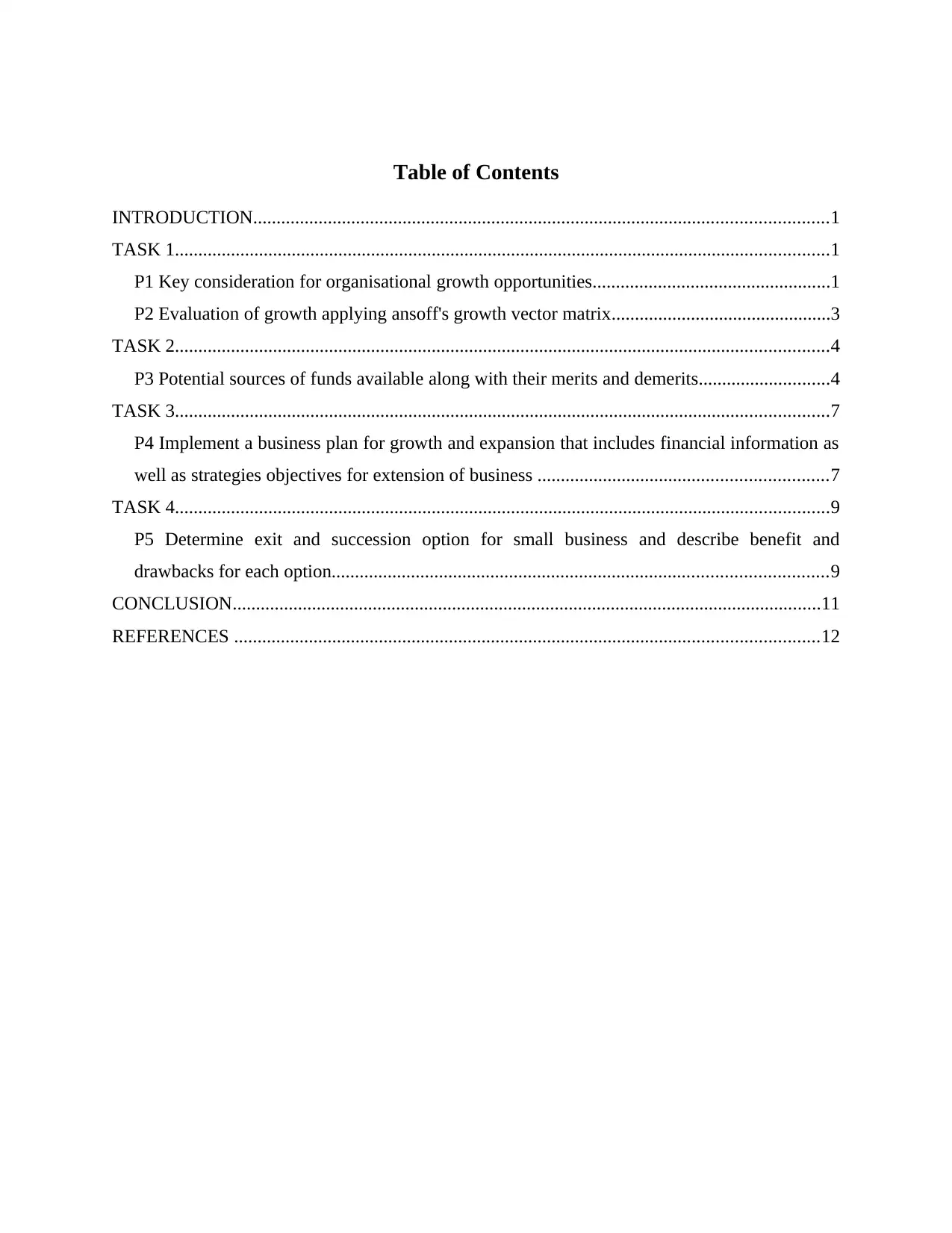
Table of Contents
INTRODUCTION...........................................................................................................................1
TASK 1............................................................................................................................................1
P1 Key consideration for organisational growth opportunities...................................................1
P2 Evaluation of growth applying ansoff's growth vector matrix...............................................3
TASK 2............................................................................................................................................4
P3 Potential sources of funds available along with their merits and demerits............................4
TASK 3............................................................................................................................................7
P4 Implement a business plan for growth and expansion that includes financial information as
well as strategies objectives for extension of business ..............................................................7
TASK 4............................................................................................................................................9
P5 Determine exit and succession option for small business and describe benefit and
drawbacks for each option..........................................................................................................9
CONCLUSION..............................................................................................................................11
REFERENCES .............................................................................................................................12
INTRODUCTION...........................................................................................................................1
TASK 1............................................................................................................................................1
P1 Key consideration for organisational growth opportunities...................................................1
P2 Evaluation of growth applying ansoff's growth vector matrix...............................................3
TASK 2............................................................................................................................................4
P3 Potential sources of funds available along with their merits and demerits............................4
TASK 3............................................................................................................................................7
P4 Implement a business plan for growth and expansion that includes financial information as
well as strategies objectives for extension of business ..............................................................7
TASK 4............................................................................................................................................9
P5 Determine exit and succession option for small business and describe benefit and
drawbacks for each option..........................................................................................................9
CONCLUSION..............................................................................................................................11
REFERENCES .............................................................................................................................12
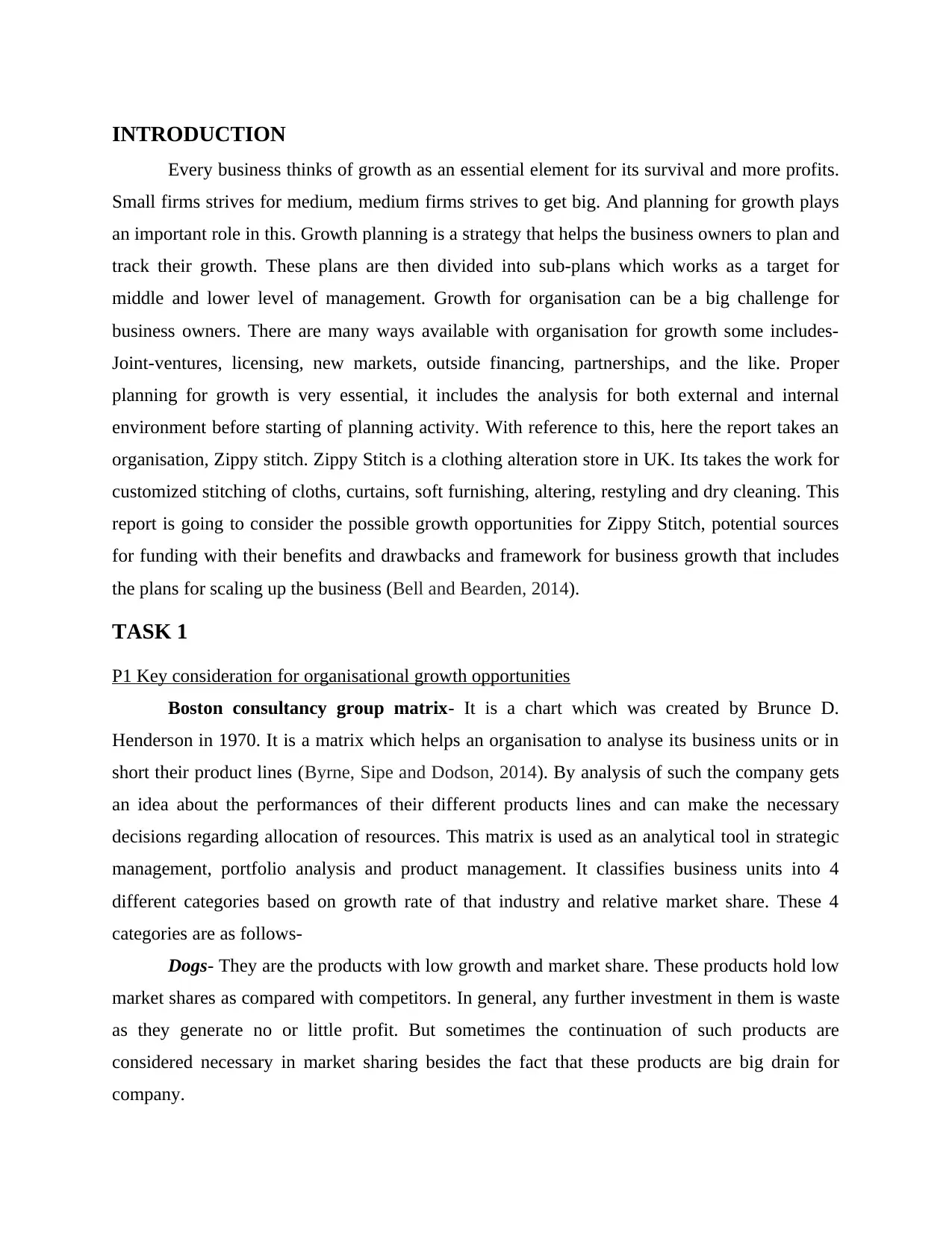
INTRODUCTION
Every business thinks of growth as an essential element for its survival and more profits.
Small firms strives for medium, medium firms strives to get big. And planning for growth plays
an important role in this. Growth planning is a strategy that helps the business owners to plan and
track their growth. These plans are then divided into sub-plans which works as a target for
middle and lower level of management. Growth for organisation can be a big challenge for
business owners. There are many ways available with organisation for growth some includes-
Joint-ventures, licensing, new markets, outside financing, partnerships, and the like. Proper
planning for growth is very essential, it includes the analysis for both external and internal
environment before starting of planning activity. With reference to this, here the report takes an
organisation, Zippy stitch. Zippy Stitch is a clothing alteration store in UK. Its takes the work for
customized stitching of cloths, curtains, soft furnishing, altering, restyling and dry cleaning. This
report is going to consider the possible growth opportunities for Zippy Stitch, potential sources
for funding with their benefits and drawbacks and framework for business growth that includes
the plans for scaling up the business (Bell and Bearden, 2014).
TASK 1
P1 Key consideration for organisational growth opportunities
Boston consultancy group matrix- It is a chart which was created by Brunce D.
Henderson in 1970. It is a matrix which helps an organisation to analyse its business units or in
short their product lines (Byrne, Sipe and Dodson, 2014). By analysis of such the company gets
an idea about the performances of their different products lines and can make the necessary
decisions regarding allocation of resources. This matrix is used as an analytical tool in strategic
management, portfolio analysis and product management. It classifies business units into 4
different categories based on growth rate of that industry and relative market share. These 4
categories are as follows-
Dogs- They are the products with low growth and market share. These products hold low
market shares as compared with competitors. In general, any further investment in them is waste
as they generate no or little profit. But sometimes the continuation of such products are
considered necessary in market sharing besides the fact that these products are big drain for
company.
Every business thinks of growth as an essential element for its survival and more profits.
Small firms strives for medium, medium firms strives to get big. And planning for growth plays
an important role in this. Growth planning is a strategy that helps the business owners to plan and
track their growth. These plans are then divided into sub-plans which works as a target for
middle and lower level of management. Growth for organisation can be a big challenge for
business owners. There are many ways available with organisation for growth some includes-
Joint-ventures, licensing, new markets, outside financing, partnerships, and the like. Proper
planning for growth is very essential, it includes the analysis for both external and internal
environment before starting of planning activity. With reference to this, here the report takes an
organisation, Zippy stitch. Zippy Stitch is a clothing alteration store in UK. Its takes the work for
customized stitching of cloths, curtains, soft furnishing, altering, restyling and dry cleaning. This
report is going to consider the possible growth opportunities for Zippy Stitch, potential sources
for funding with their benefits and drawbacks and framework for business growth that includes
the plans for scaling up the business (Bell and Bearden, 2014).
TASK 1
P1 Key consideration for organisational growth opportunities
Boston consultancy group matrix- It is a chart which was created by Brunce D.
Henderson in 1970. It is a matrix which helps an organisation to analyse its business units or in
short their product lines (Byrne, Sipe and Dodson, 2014). By analysis of such the company gets
an idea about the performances of their different products lines and can make the necessary
decisions regarding allocation of resources. This matrix is used as an analytical tool in strategic
management, portfolio analysis and product management. It classifies business units into 4
different categories based on growth rate of that industry and relative market share. These 4
categories are as follows-
Dogs- They are the products with low growth and market share. These products hold low
market shares as compared with competitors. In general, any further investment in them is waste
as they generate no or little profit. But sometimes the continuation of such products are
considered necessary in market sharing besides the fact that these products are big drain for
company.
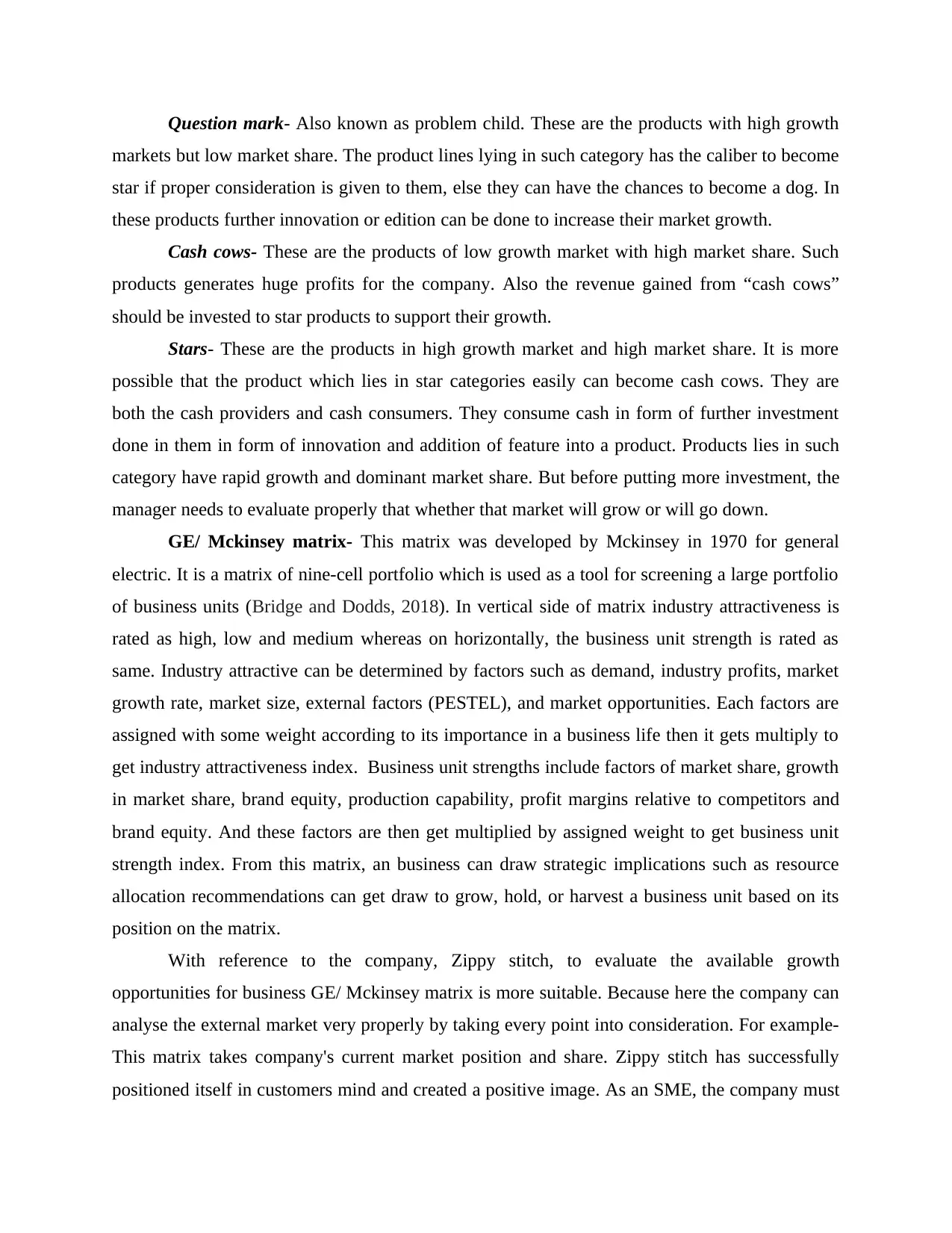
Question mark- Also known as problem child. These are the products with high growth
markets but low market share. The product lines lying in such category has the caliber to become
star if proper consideration is given to them, else they can have the chances to become a dog. In
these products further innovation or edition can be done to increase their market growth.
Cash cows- These are the products of low growth market with high market share. Such
products generates huge profits for the company. Also the revenue gained from “cash cows”
should be invested to star products to support their growth.
Stars- These are the products in high growth market and high market share. It is more
possible that the product which lies in star categories easily can become cash cows. They are
both the cash providers and cash consumers. They consume cash in form of further investment
done in them in form of innovation and addition of feature into a product. Products lies in such
category have rapid growth and dominant market share. But before putting more investment, the
manager needs to evaluate properly that whether that market will grow or will go down.
GE/ Mckinsey matrix- This matrix was developed by Mckinsey in 1970 for general
electric. It is a matrix of nine-cell portfolio which is used as a tool for screening a large portfolio
of business units (Bridge and Dodds, 2018). In vertical side of matrix industry attractiveness is
rated as high, low and medium whereas on horizontally, the business unit strength is rated as
same. Industry attractive can be determined by factors such as demand, industry profits, market
growth rate, market size, external factors (PESTEL), and market opportunities. Each factors are
assigned with some weight according to its importance in a business life then it gets multiply to
get industry attractiveness index. Business unit strengths include factors of market share, growth
in market share, brand equity, production capability, profit margins relative to competitors and
brand equity. And these factors are then get multiplied by assigned weight to get business unit
strength index. From this matrix, an business can draw strategic implications such as resource
allocation recommendations can get draw to grow, hold, or harvest a business unit based on its
position on the matrix.
With reference to the company, Zippy stitch, to evaluate the available growth
opportunities for business GE/ Mckinsey matrix is more suitable. Because here the company can
analyse the external market very properly by taking every point into consideration. For example-
This matrix takes company's current market position and share. Zippy stitch has successfully
positioned itself in customers mind and created a positive image. As an SME, the company must
markets but low market share. The product lines lying in such category has the caliber to become
star if proper consideration is given to them, else they can have the chances to become a dog. In
these products further innovation or edition can be done to increase their market growth.
Cash cows- These are the products of low growth market with high market share. Such
products generates huge profits for the company. Also the revenue gained from “cash cows”
should be invested to star products to support their growth.
Stars- These are the products in high growth market and high market share. It is more
possible that the product which lies in star categories easily can become cash cows. They are
both the cash providers and cash consumers. They consume cash in form of further investment
done in them in form of innovation and addition of feature into a product. Products lies in such
category have rapid growth and dominant market share. But before putting more investment, the
manager needs to evaluate properly that whether that market will grow or will go down.
GE/ Mckinsey matrix- This matrix was developed by Mckinsey in 1970 for general
electric. It is a matrix of nine-cell portfolio which is used as a tool for screening a large portfolio
of business units (Bridge and Dodds, 2018). In vertical side of matrix industry attractiveness is
rated as high, low and medium whereas on horizontally, the business unit strength is rated as
same. Industry attractive can be determined by factors such as demand, industry profits, market
growth rate, market size, external factors (PESTEL), and market opportunities. Each factors are
assigned with some weight according to its importance in a business life then it gets multiply to
get industry attractiveness index. Business unit strengths include factors of market share, growth
in market share, brand equity, production capability, profit margins relative to competitors and
brand equity. And these factors are then get multiplied by assigned weight to get business unit
strength index. From this matrix, an business can draw strategic implications such as resource
allocation recommendations can get draw to grow, hold, or harvest a business unit based on its
position on the matrix.
With reference to the company, Zippy stitch, to evaluate the available growth
opportunities for business GE/ Mckinsey matrix is more suitable. Because here the company can
analyse the external market very properly by taking every point into consideration. For example-
This matrix takes company's current market position and share. Zippy stitch has successfully
positioned itself in customers mind and created a positive image. As an SME, the company must
Secure Best Marks with AI Grader
Need help grading? Try our AI Grader for instant feedback on your assignments.
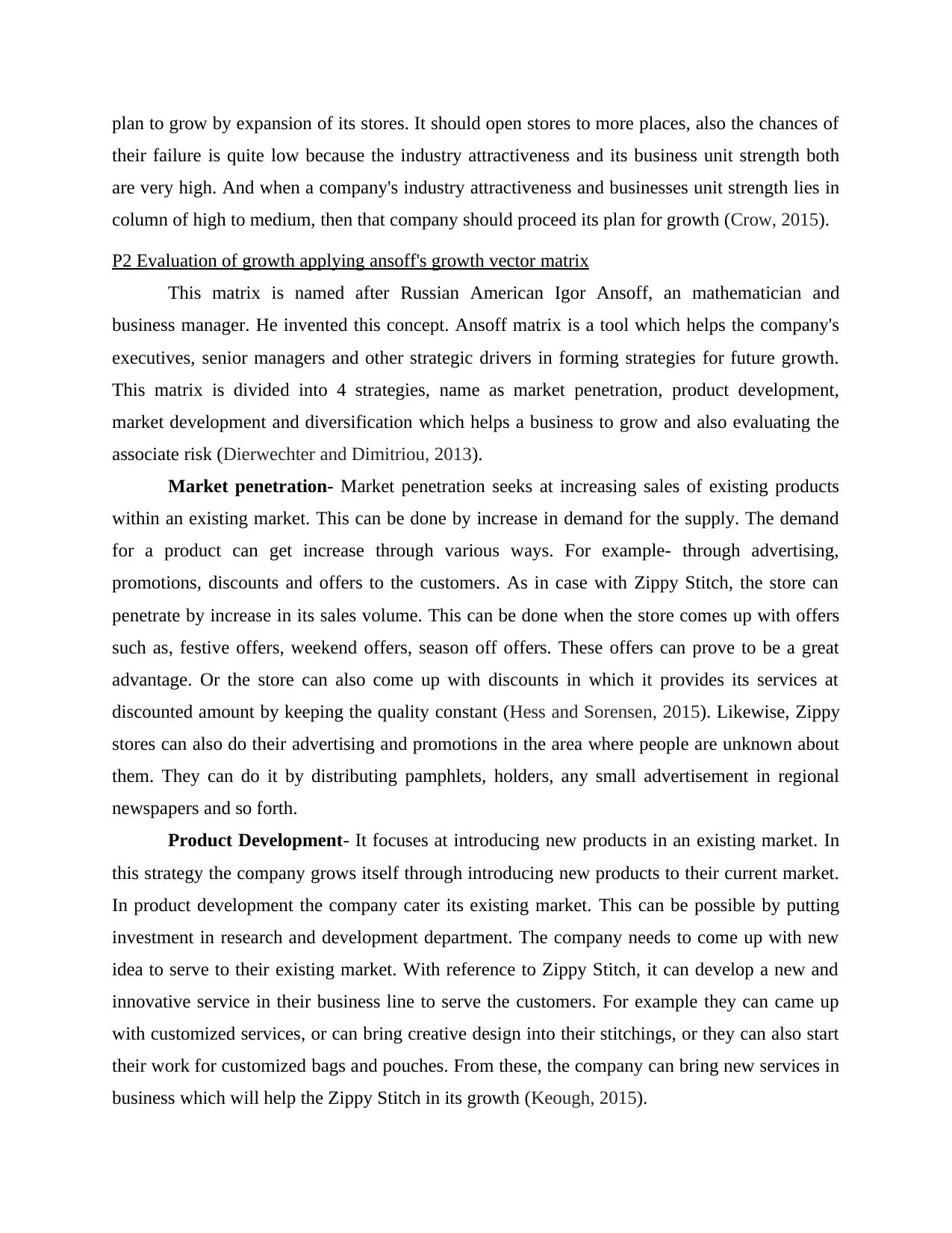
plan to grow by expansion of its stores. It should open stores to more places, also the chances of
their failure is quite low because the industry attractiveness and its business unit strength both
are very high. And when a company's industry attractiveness and businesses unit strength lies in
column of high to medium, then that company should proceed its plan for growth (Crow, 2015).
P2 Evaluation of growth applying ansoff's growth vector matrix
This matrix is named after Russian American Igor Ansoff, an mathematician and
business manager. He invented this concept. Ansoff matrix is a tool which helps the company's
executives, senior managers and other strategic drivers in forming strategies for future growth.
This matrix is divided into 4 strategies, name as market penetration, product development,
market development and diversification which helps a business to grow and also evaluating the
associate risk (Dierwechter and Dimitriou, 2013).
Market penetration- Market penetration seeks at increasing sales of existing products
within an existing market. This can be done by increase in demand for the supply. The demand
for a product can get increase through various ways. For example- through advertising,
promotions, discounts and offers to the customers. As in case with Zippy Stitch, the store can
penetrate by increase in its sales volume. This can be done when the store comes up with offers
such as, festive offers, weekend offers, season off offers. These offers can prove to be a great
advantage. Or the store can also come up with discounts in which it provides its services at
discounted amount by keeping the quality constant (Hess and Sorensen, 2015). Likewise, Zippy
stores can also do their advertising and promotions in the area where people are unknown about
them. They can do it by distributing pamphlets, holders, any small advertisement in regional
newspapers and so forth.
Product Development- It focuses at introducing new products in an existing market. In
this strategy the company grows itself through introducing new products to their current market.
In product development the company cater its existing market. This can be possible by putting
investment in research and development department. The company needs to come up with new
idea to serve to their existing market. With reference to Zippy Stitch, it can develop a new and
innovative service in their business line to serve the customers. For example they can came up
with customized services, or can bring creative design into their stitchings, or they can also start
their work for customized bags and pouches. From these, the company can bring new services in
business which will help the Zippy Stitch in its growth (Keough, 2015).
their failure is quite low because the industry attractiveness and its business unit strength both
are very high. And when a company's industry attractiveness and businesses unit strength lies in
column of high to medium, then that company should proceed its plan for growth (Crow, 2015).
P2 Evaluation of growth applying ansoff's growth vector matrix
This matrix is named after Russian American Igor Ansoff, an mathematician and
business manager. He invented this concept. Ansoff matrix is a tool which helps the company's
executives, senior managers and other strategic drivers in forming strategies for future growth.
This matrix is divided into 4 strategies, name as market penetration, product development,
market development and diversification which helps a business to grow and also evaluating the
associate risk (Dierwechter and Dimitriou, 2013).
Market penetration- Market penetration seeks at increasing sales of existing products
within an existing market. This can be done by increase in demand for the supply. The demand
for a product can get increase through various ways. For example- through advertising,
promotions, discounts and offers to the customers. As in case with Zippy Stitch, the store can
penetrate by increase in its sales volume. This can be done when the store comes up with offers
such as, festive offers, weekend offers, season off offers. These offers can prove to be a great
advantage. Or the store can also come up with discounts in which it provides its services at
discounted amount by keeping the quality constant (Hess and Sorensen, 2015). Likewise, Zippy
stores can also do their advertising and promotions in the area where people are unknown about
them. They can do it by distributing pamphlets, holders, any small advertisement in regional
newspapers and so forth.
Product Development- It focuses at introducing new products in an existing market. In
this strategy the company grows itself through introducing new products to their current market.
In product development the company cater its existing market. This can be possible by putting
investment in research and development department. The company needs to come up with new
idea to serve to their existing market. With reference to Zippy Stitch, it can develop a new and
innovative service in their business line to serve the customers. For example they can came up
with customized services, or can bring creative design into their stitchings, or they can also start
their work for customized bags and pouches. From these, the company can bring new services in
business which will help the Zippy Stitch in its growth (Keough, 2015).
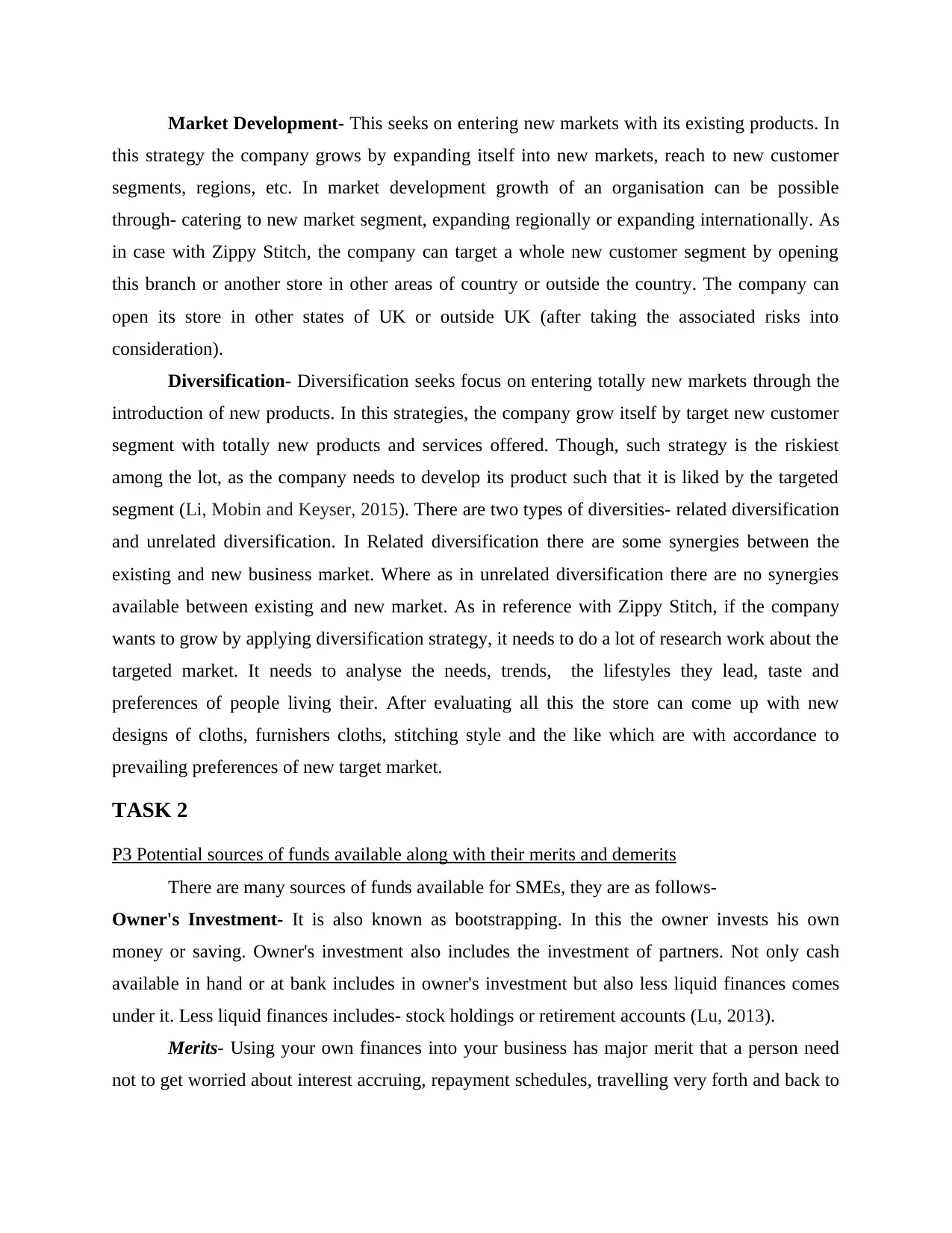
Market Development- This seeks on entering new markets with its existing products. In
this strategy the company grows by expanding itself into new markets, reach to new customer
segments, regions, etc. In market development growth of an organisation can be possible
through- catering to new market segment, expanding regionally or expanding internationally. As
in case with Zippy Stitch, the company can target a whole new customer segment by opening
this branch or another store in other areas of country or outside the country. The company can
open its store in other states of UK or outside UK (after taking the associated risks into
consideration).
Diversification- Diversification seeks focus on entering totally new markets through the
introduction of new products. In this strategies, the company grow itself by target new customer
segment with totally new products and services offered. Though, such strategy is the riskiest
among the lot, as the company needs to develop its product such that it is liked by the targeted
segment (Li, Mobin and Keyser, 2015). There are two types of diversities- related diversification
and unrelated diversification. In Related diversification there are some synergies between the
existing and new business market. Where as in unrelated diversification there are no synergies
available between existing and new market. As in reference with Zippy Stitch, if the company
wants to grow by applying diversification strategy, it needs to do a lot of research work about the
targeted market. It needs to analyse the needs, trends, the lifestyles they lead, taste and
preferences of people living their. After evaluating all this the store can come up with new
designs of cloths, furnishers cloths, stitching style and the like which are with accordance to
prevailing preferences of new target market.
TASK 2
P3 Potential sources of funds available along with their merits and demerits
There are many sources of funds available for SMEs, they are as follows-
Owner's Investment- It is also known as bootstrapping. In this the owner invests his own
money or saving. Owner's investment also includes the investment of partners. Not only cash
available in hand or at bank includes in owner's investment but also less liquid finances comes
under it. Less liquid finances includes- stock holdings or retirement accounts (Lu, 2013).
Merits- Using your own finances into your business has major merit that a person need
not to get worried about interest accruing, repayment schedules, travelling very forth and back to
this strategy the company grows by expanding itself into new markets, reach to new customer
segments, regions, etc. In market development growth of an organisation can be possible
through- catering to new market segment, expanding regionally or expanding internationally. As
in case with Zippy Stitch, the company can target a whole new customer segment by opening
this branch or another store in other areas of country or outside the country. The company can
open its store in other states of UK or outside UK (after taking the associated risks into
consideration).
Diversification- Diversification seeks focus on entering totally new markets through the
introduction of new products. In this strategies, the company grow itself by target new customer
segment with totally new products and services offered. Though, such strategy is the riskiest
among the lot, as the company needs to develop its product such that it is liked by the targeted
segment (Li, Mobin and Keyser, 2015). There are two types of diversities- related diversification
and unrelated diversification. In Related diversification there are some synergies between the
existing and new business market. Where as in unrelated diversification there are no synergies
available between existing and new market. As in reference with Zippy Stitch, if the company
wants to grow by applying diversification strategy, it needs to do a lot of research work about the
targeted market. It needs to analyse the needs, trends, the lifestyles they lead, taste and
preferences of people living their. After evaluating all this the store can come up with new
designs of cloths, furnishers cloths, stitching style and the like which are with accordance to
prevailing preferences of new target market.
TASK 2
P3 Potential sources of funds available along with their merits and demerits
There are many sources of funds available for SMEs, they are as follows-
Owner's Investment- It is also known as bootstrapping. In this the owner invests his own
money or saving. Owner's investment also includes the investment of partners. Not only cash
available in hand or at bank includes in owner's investment but also less liquid finances comes
under it. Less liquid finances includes- stock holdings or retirement accounts (Lu, 2013).
Merits- Using your own finances into your business has major merit that a person need
not to get worried about interest accruing, repayment schedules, travelling very forth and back to
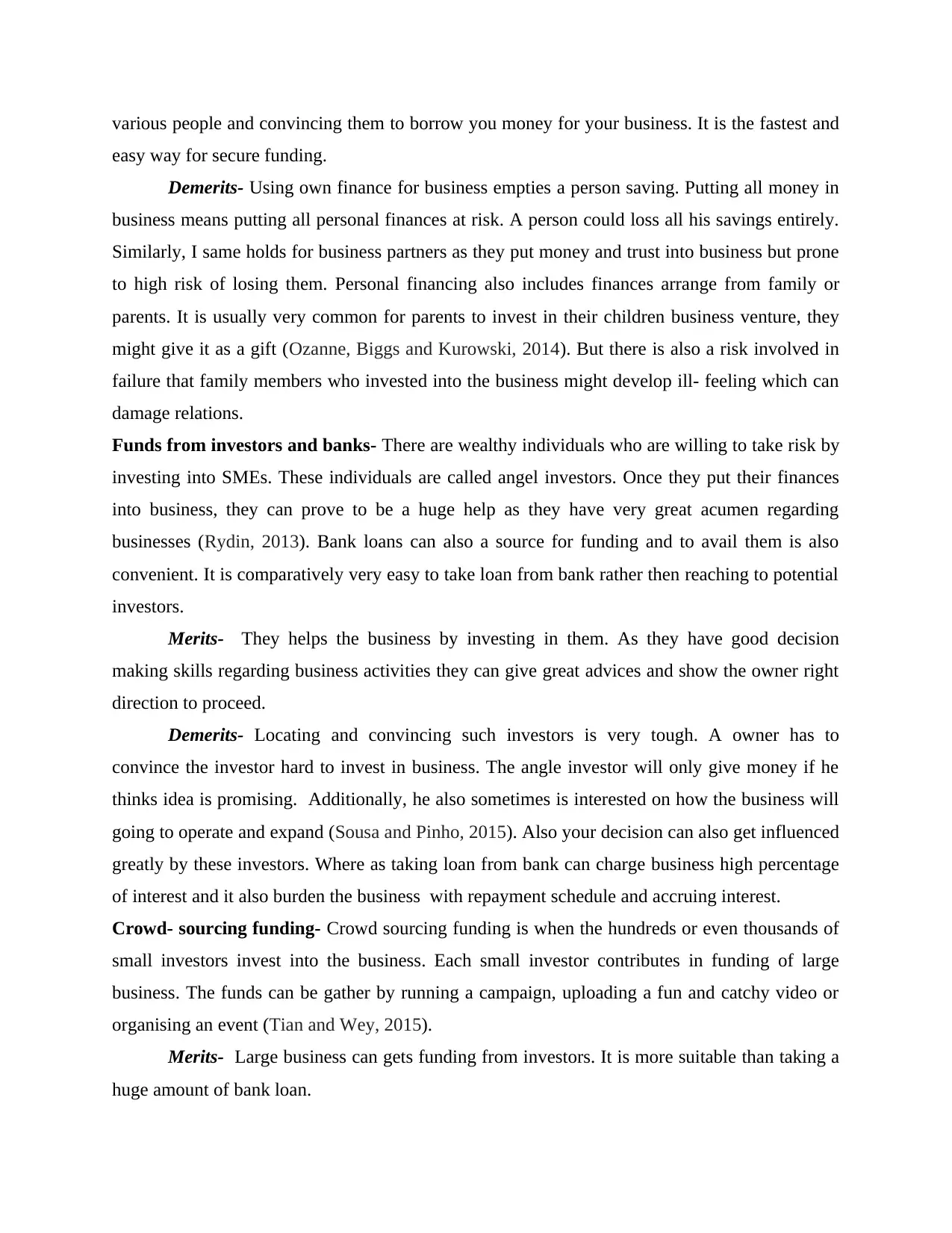
various people and convincing them to borrow you money for your business. It is the fastest and
easy way for secure funding.
Demerits- Using own finance for business empties a person saving. Putting all money in
business means putting all personal finances at risk. A person could loss all his savings entirely.
Similarly, I same holds for business partners as they put money and trust into business but prone
to high risk of losing them. Personal financing also includes finances arrange from family or
parents. It is usually very common for parents to invest in their children business venture, they
might give it as a gift (Ozanne, Biggs and Kurowski, 2014). But there is also a risk involved in
failure that family members who invested into the business might develop ill- feeling which can
damage relations.
Funds from investors and banks- There are wealthy individuals who are willing to take risk by
investing into SMEs. These individuals are called angel investors. Once they put their finances
into business, they can prove to be a huge help as they have very great acumen regarding
businesses (Rydin, 2013). Bank loans can also a source for funding and to avail them is also
convenient. It is comparatively very easy to take loan from bank rather then reaching to potential
investors.
Merits- They helps the business by investing in them. As they have good decision
making skills regarding business activities they can give great advices and show the owner right
direction to proceed.
Demerits- Locating and convincing such investors is very tough. A owner has to
convince the investor hard to invest in business. The angle investor will only give money if he
thinks idea is promising. Additionally, he also sometimes is interested on how the business will
going to operate and expand (Sousa and Pinho, 2015). Also your decision can also get influenced
greatly by these investors. Where as taking loan from bank can charge business high percentage
of interest and it also burden the business with repayment schedule and accruing interest.
Crowd- sourcing funding- Crowd sourcing funding is when the hundreds or even thousands of
small investors invest into the business. Each small investor contributes in funding of large
business. The funds can be gather by running a campaign, uploading a fun and catchy video or
organising an event (Tian and Wey, 2015).
Merits- Large business can gets funding from investors. It is more suitable than taking a
huge amount of bank loan.
easy way for secure funding.
Demerits- Using own finance for business empties a person saving. Putting all money in
business means putting all personal finances at risk. A person could loss all his savings entirely.
Similarly, I same holds for business partners as they put money and trust into business but prone
to high risk of losing them. Personal financing also includes finances arrange from family or
parents. It is usually very common for parents to invest in their children business venture, they
might give it as a gift (Ozanne, Biggs and Kurowski, 2014). But there is also a risk involved in
failure that family members who invested into the business might develop ill- feeling which can
damage relations.
Funds from investors and banks- There are wealthy individuals who are willing to take risk by
investing into SMEs. These individuals are called angel investors. Once they put their finances
into business, they can prove to be a huge help as they have very great acumen regarding
businesses (Rydin, 2013). Bank loans can also a source for funding and to avail them is also
convenient. It is comparatively very easy to take loan from bank rather then reaching to potential
investors.
Merits- They helps the business by investing in them. As they have good decision
making skills regarding business activities they can give great advices and show the owner right
direction to proceed.
Demerits- Locating and convincing such investors is very tough. A owner has to
convince the investor hard to invest in business. The angle investor will only give money if he
thinks idea is promising. Additionally, he also sometimes is interested on how the business will
going to operate and expand (Sousa and Pinho, 2015). Also your decision can also get influenced
greatly by these investors. Where as taking loan from bank can charge business high percentage
of interest and it also burden the business with repayment schedule and accruing interest.
Crowd- sourcing funding- Crowd sourcing funding is when the hundreds or even thousands of
small investors invest into the business. Each small investor contributes in funding of large
business. The funds can be gather by running a campaign, uploading a fun and catchy video or
organising an event (Tian and Wey, 2015).
Merits- Large business can gets funding from investors. It is more suitable than taking a
huge amount of bank loan.
Paraphrase This Document
Need a fresh take? Get an instant paraphrase of this document with our AI Paraphraser
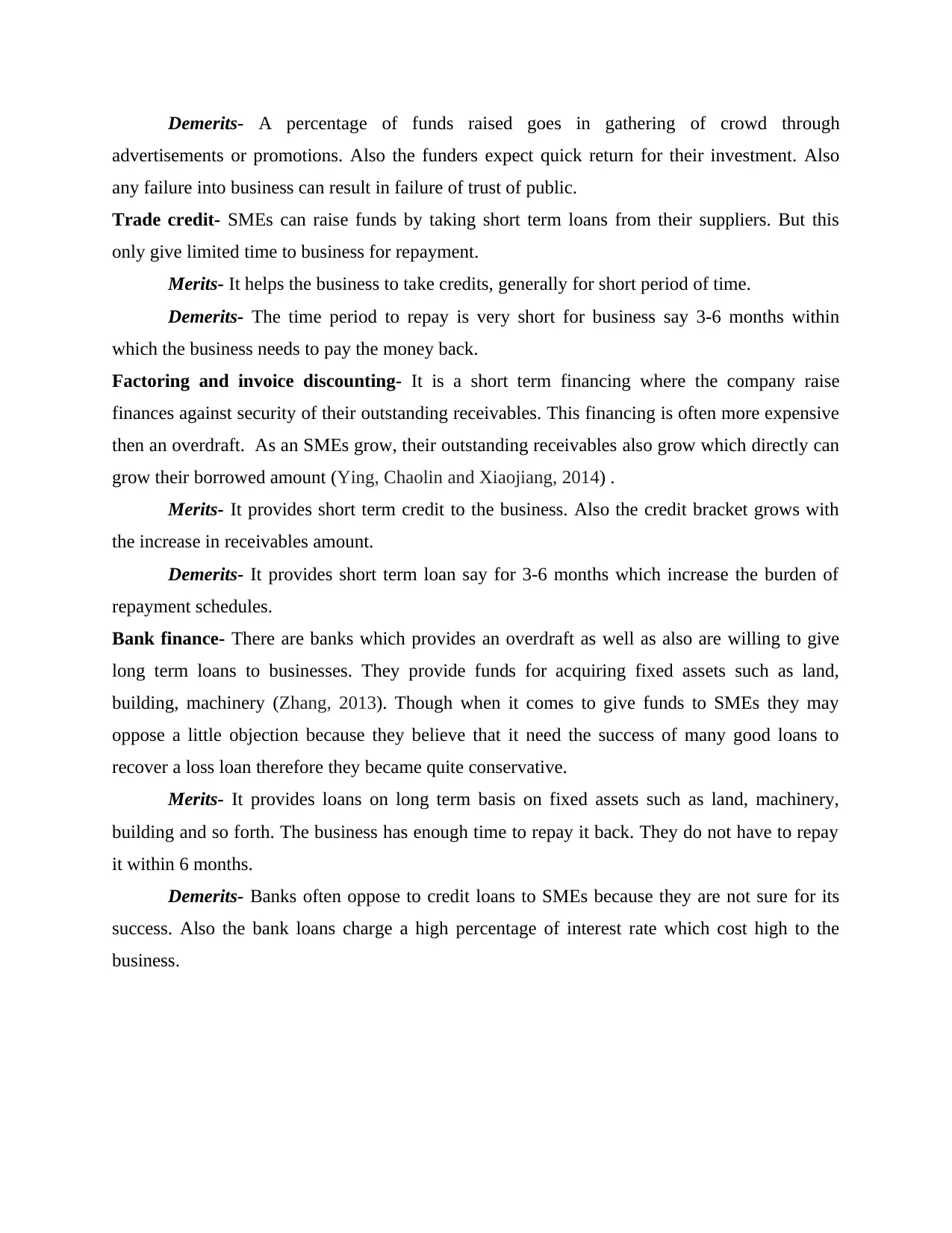
Demerits- A percentage of funds raised goes in gathering of crowd through
advertisements or promotions. Also the funders expect quick return for their investment. Also
any failure into business can result in failure of trust of public.
Trade credit- SMEs can raise funds by taking short term loans from their suppliers. But this
only give limited time to business for repayment.
Merits- It helps the business to take credits, generally for short period of time.
Demerits- The time period to repay is very short for business say 3-6 months within
which the business needs to pay the money back.
Factoring and invoice discounting- It is a short term financing where the company raise
finances against security of their outstanding receivables. This financing is often more expensive
then an overdraft. As an SMEs grow, their outstanding receivables also grow which directly can
grow their borrowed amount (Ying, Chaolin and Xiaojiang, 2014) .
Merits- It provides short term credit to the business. Also the credit bracket grows with
the increase in receivables amount.
Demerits- It provides short term loan say for 3-6 months which increase the burden of
repayment schedules.
Bank finance- There are banks which provides an overdraft as well as also are willing to give
long term loans to businesses. They provide funds for acquiring fixed assets such as land,
building, machinery (Zhang, 2013). Though when it comes to give funds to SMEs they may
oppose a little objection because they believe that it need the success of many good loans to
recover a loss loan therefore they became quite conservative.
Merits- It provides loans on long term basis on fixed assets such as land, machinery,
building and so forth. The business has enough time to repay it back. They do not have to repay
it within 6 months.
Demerits- Banks often oppose to credit loans to SMEs because they are not sure for its
success. Also the bank loans charge a high percentage of interest rate which cost high to the
business.
advertisements or promotions. Also the funders expect quick return for their investment. Also
any failure into business can result in failure of trust of public.
Trade credit- SMEs can raise funds by taking short term loans from their suppliers. But this
only give limited time to business for repayment.
Merits- It helps the business to take credits, generally for short period of time.
Demerits- The time period to repay is very short for business say 3-6 months within
which the business needs to pay the money back.
Factoring and invoice discounting- It is a short term financing where the company raise
finances against security of their outstanding receivables. This financing is often more expensive
then an overdraft. As an SMEs grow, their outstanding receivables also grow which directly can
grow their borrowed amount (Ying, Chaolin and Xiaojiang, 2014) .
Merits- It provides short term credit to the business. Also the credit bracket grows with
the increase in receivables amount.
Demerits- It provides short term loan say for 3-6 months which increase the burden of
repayment schedules.
Bank finance- There are banks which provides an overdraft as well as also are willing to give
long term loans to businesses. They provide funds for acquiring fixed assets such as land,
building, machinery (Zhang, 2013). Though when it comes to give funds to SMEs they may
oppose a little objection because they believe that it need the success of many good loans to
recover a loss loan therefore they became quite conservative.
Merits- It provides loans on long term basis on fixed assets such as land, machinery,
building and so forth. The business has enough time to repay it back. They do not have to repay
it within 6 months.
Demerits- Banks often oppose to credit loans to SMEs because they are not sure for its
success. Also the bank loans charge a high percentage of interest rate which cost high to the
business.
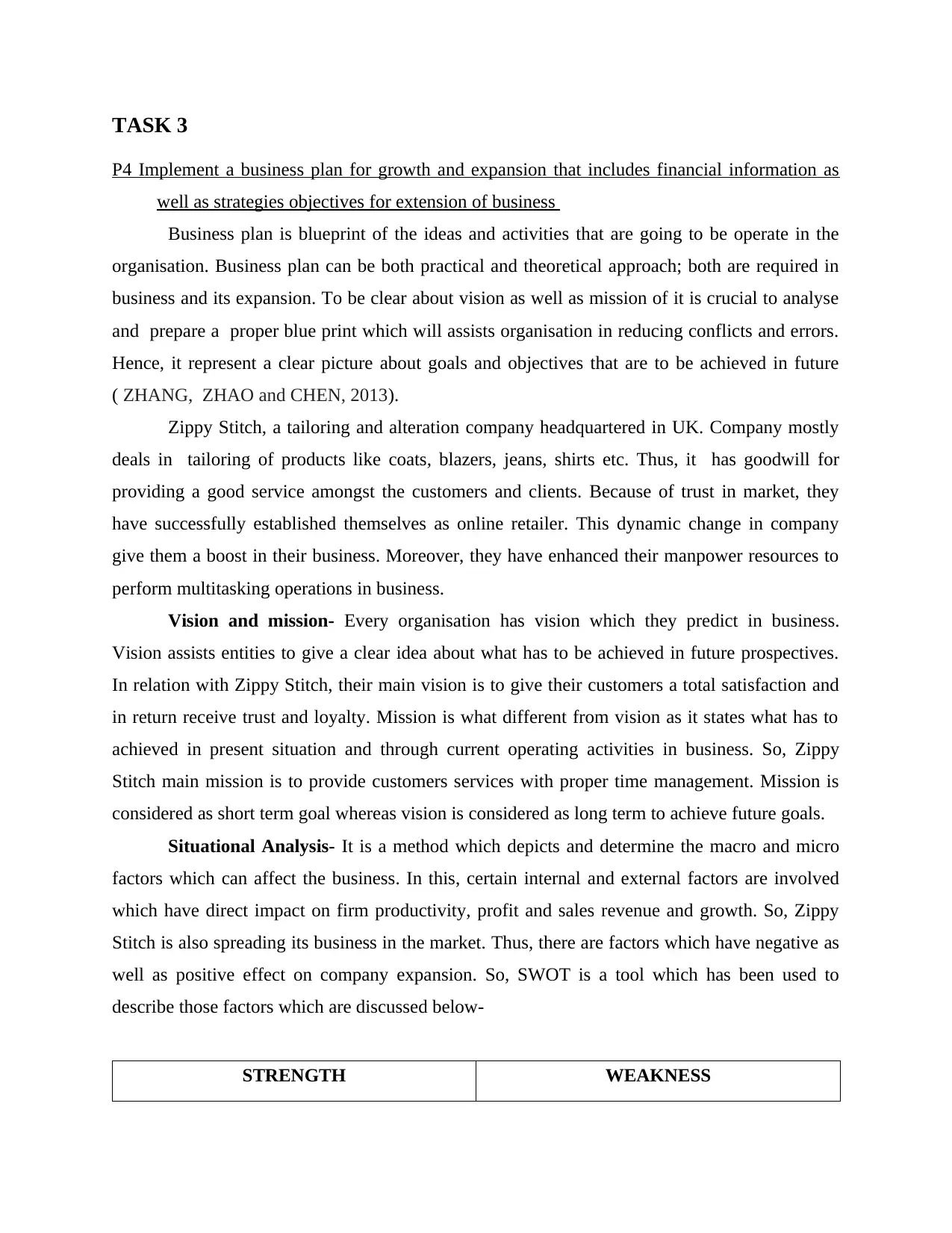
TASK 3
P4 Implement a business plan for growth and expansion that includes financial information as
well as strategies objectives for extension of business
Business plan is blueprint of the ideas and activities that are going to be operate in the
organisation. Business plan can be both practical and theoretical approach; both are required in
business and its expansion. To be clear about vision as well as mission of it is crucial to analyse
and prepare a proper blue print which will assists organisation in reducing conflicts and errors.
Hence, it represent a clear picture about goals and objectives that are to be achieved in future
( ZHANG, ZHAO and CHEN, 2013).
Zippy Stitch, a tailoring and alteration company headquartered in UK. Company mostly
deals in tailoring of products like coats, blazers, jeans, shirts etc. Thus, it has goodwill for
providing a good service amongst the customers and clients. Because of trust in market, they
have successfully established themselves as online retailer. This dynamic change in company
give them a boost in their business. Moreover, they have enhanced their manpower resources to
perform multitasking operations in business.
Vision and mission- Every organisation has vision which they predict in business.
Vision assists entities to give a clear idea about what has to be achieved in future prospectives.
In relation with Zippy Stitch, their main vision is to give their customers a total satisfaction and
in return receive trust and loyalty. Mission is what different from vision as it states what has to
achieved in present situation and through current operating activities in business. So, Zippy
Stitch main mission is to provide customers services with proper time management. Mission is
considered as short term goal whereas vision is considered as long term to achieve future goals.
Situational Analysis- It is a method which depicts and determine the macro and micro
factors which can affect the business. In this, certain internal and external factors are involved
which have direct impact on firm productivity, profit and sales revenue and growth. So, Zippy
Stitch is also spreading its business in the market. Thus, there are factors which have negative as
well as positive effect on company expansion. So, SWOT is a tool which has been used to
describe those factors which are discussed below-
STRENGTH WEAKNESS
P4 Implement a business plan for growth and expansion that includes financial information as
well as strategies objectives for extension of business
Business plan is blueprint of the ideas and activities that are going to be operate in the
organisation. Business plan can be both practical and theoretical approach; both are required in
business and its expansion. To be clear about vision as well as mission of it is crucial to analyse
and prepare a proper blue print which will assists organisation in reducing conflicts and errors.
Hence, it represent a clear picture about goals and objectives that are to be achieved in future
( ZHANG, ZHAO and CHEN, 2013).
Zippy Stitch, a tailoring and alteration company headquartered in UK. Company mostly
deals in tailoring of products like coats, blazers, jeans, shirts etc. Thus, it has goodwill for
providing a good service amongst the customers and clients. Because of trust in market, they
have successfully established themselves as online retailer. This dynamic change in company
give them a boost in their business. Moreover, they have enhanced their manpower resources to
perform multitasking operations in business.
Vision and mission- Every organisation has vision which they predict in business.
Vision assists entities to give a clear idea about what has to be achieved in future prospectives.
In relation with Zippy Stitch, their main vision is to give their customers a total satisfaction and
in return receive trust and loyalty. Mission is what different from vision as it states what has to
achieved in present situation and through current operating activities in business. So, Zippy
Stitch main mission is to provide customers services with proper time management. Mission is
considered as short term goal whereas vision is considered as long term to achieve future goals.
Situational Analysis- It is a method which depicts and determine the macro and micro
factors which can affect the business. In this, certain internal and external factors are involved
which have direct impact on firm productivity, profit and sales revenue and growth. So, Zippy
Stitch is also spreading its business in the market. Thus, there are factors which have negative as
well as positive effect on company expansion. So, SWOT is a tool which has been used to
describe those factors which are discussed below-
STRENGTH WEAKNESS
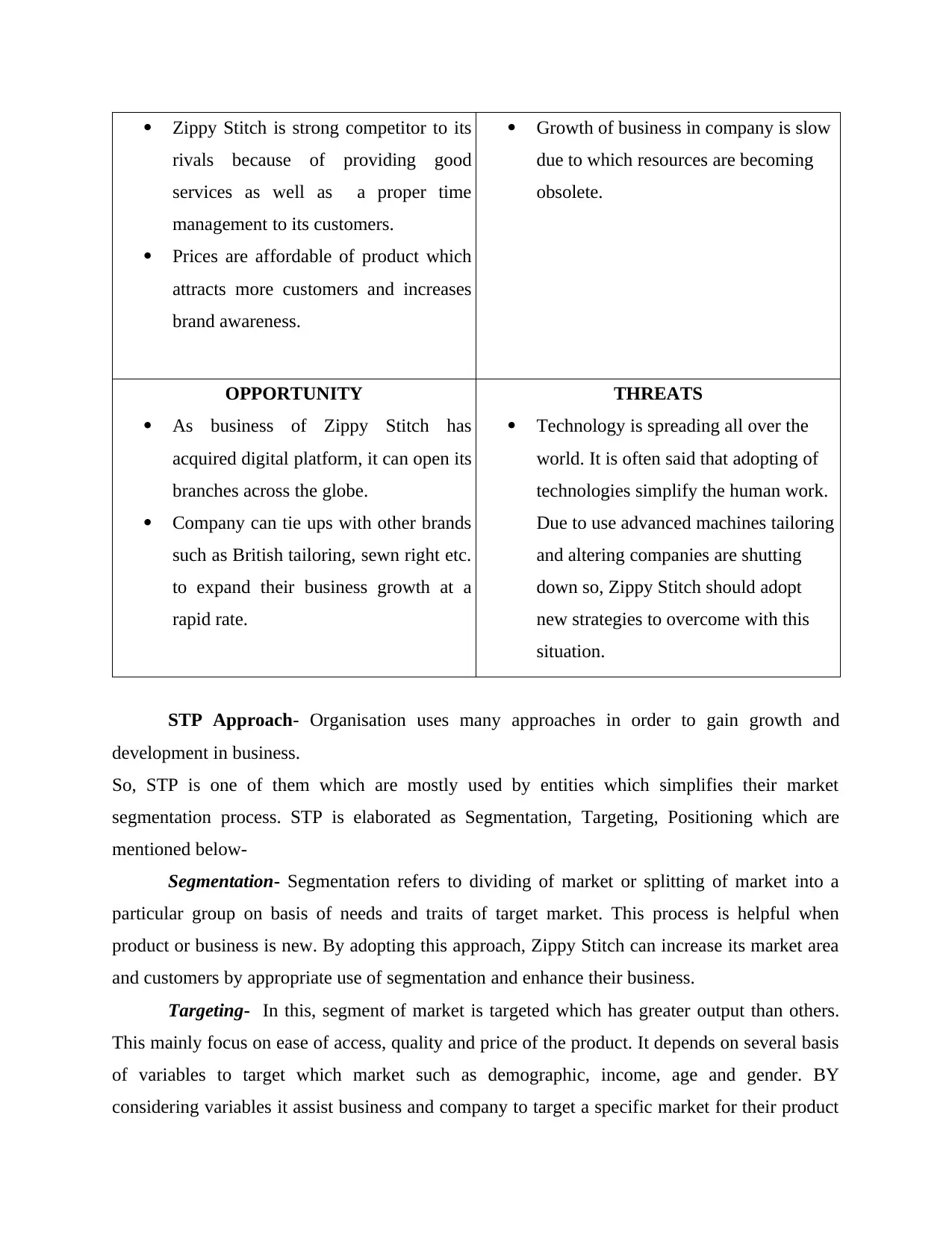
Zippy Stitch is strong competitor to its
rivals because of providing good
services as well as a proper time
management to its customers.
Prices are affordable of product which
attracts more customers and increases
brand awareness.
Growth of business in company is slow
due to which resources are becoming
obsolete.
OPPORTUNITY
As business of Zippy Stitch has
acquired digital platform, it can open its
branches across the globe.
Company can tie ups with other brands
such as British tailoring, sewn right etc.
to expand their business growth at a
rapid rate.
THREATS
Technology is spreading all over the
world. It is often said that adopting of
technologies simplify the human work.
Due to use advanced machines tailoring
and altering companies are shutting
down so, Zippy Stitch should adopt
new strategies to overcome with this
situation.
STP Approach- Organisation uses many approaches in order to gain growth and
development in business.
So, STP is one of them which are mostly used by entities which simplifies their market
segmentation process. STP is elaborated as Segmentation, Targeting, Positioning which are
mentioned below-
Segmentation- Segmentation refers to dividing of market or splitting of market into a
particular group on basis of needs and traits of target market. This process is helpful when
product or business is new. By adopting this approach, Zippy Stitch can increase its market area
and customers by appropriate use of segmentation and enhance their business.
Targeting- In this, segment of market is targeted which has greater output than others.
This mainly focus on ease of access, quality and price of the product. It depends on several basis
of variables to target which market such as demographic, income, age and gender. BY
considering variables it assist business and company to target a specific market for their product
rivals because of providing good
services as well as a proper time
management to its customers.
Prices are affordable of product which
attracts more customers and increases
brand awareness.
Growth of business in company is slow
due to which resources are becoming
obsolete.
OPPORTUNITY
As business of Zippy Stitch has
acquired digital platform, it can open its
branches across the globe.
Company can tie ups with other brands
such as British tailoring, sewn right etc.
to expand their business growth at a
rapid rate.
THREATS
Technology is spreading all over the
world. It is often said that adopting of
technologies simplify the human work.
Due to use advanced machines tailoring
and altering companies are shutting
down so, Zippy Stitch should adopt
new strategies to overcome with this
situation.
STP Approach- Organisation uses many approaches in order to gain growth and
development in business.
So, STP is one of them which are mostly used by entities which simplifies their market
segmentation process. STP is elaborated as Segmentation, Targeting, Positioning which are
mentioned below-
Segmentation- Segmentation refers to dividing of market or splitting of market into a
particular group on basis of needs and traits of target market. This process is helpful when
product or business is new. By adopting this approach, Zippy Stitch can increase its market area
and customers by appropriate use of segmentation and enhance their business.
Targeting- In this, segment of market is targeted which has greater output than others.
This mainly focus on ease of access, quality and price of the product. It depends on several basis
of variables to target which market such as demographic, income, age and gender. BY
considering variables it assist business and company to target a specific market for their product
Secure Best Marks with AI Grader
Need help grading? Try our AI Grader for instant feedback on your assignments.
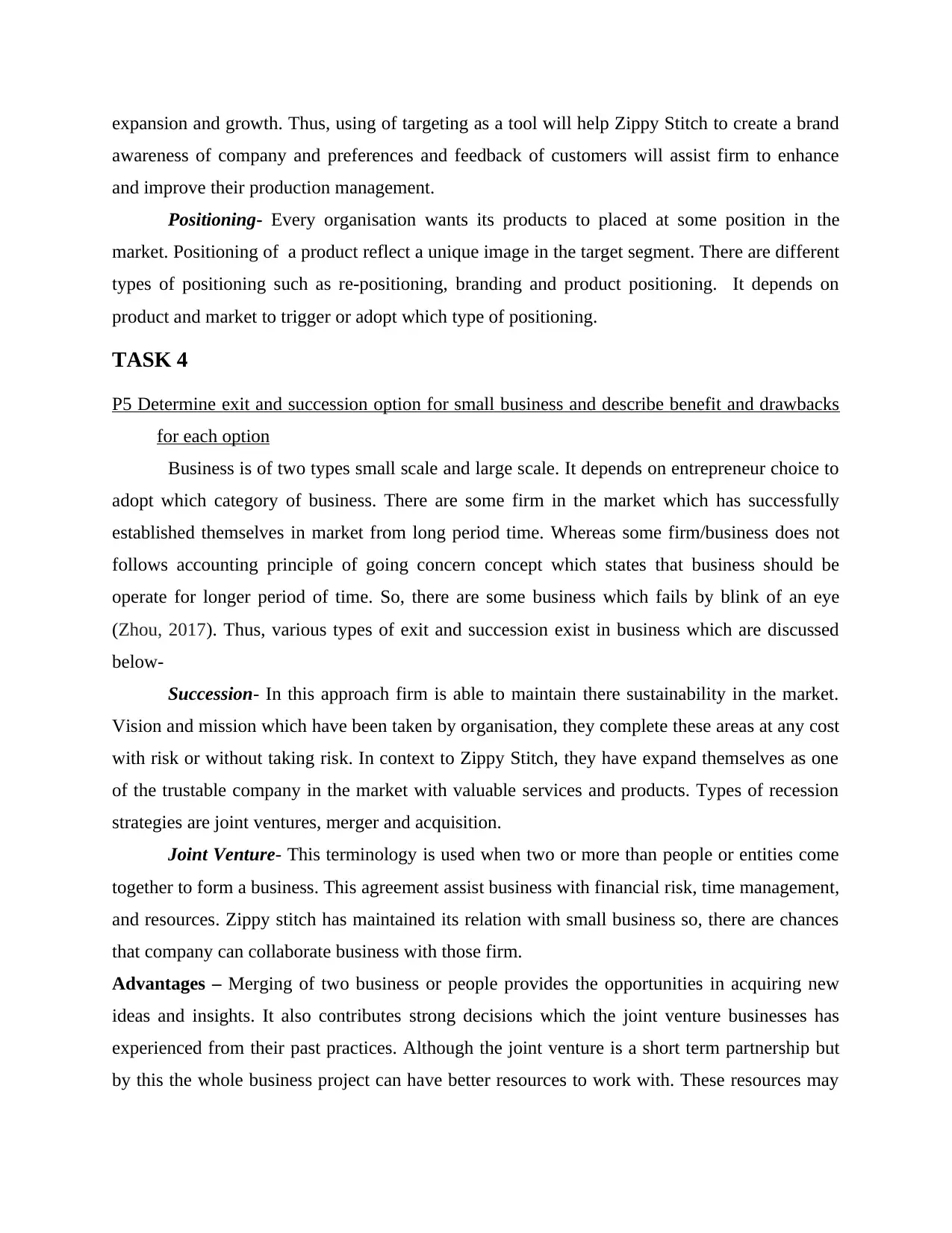
expansion and growth. Thus, using of targeting as a tool will help Zippy Stitch to create a brand
awareness of company and preferences and feedback of customers will assist firm to enhance
and improve their production management.
Positioning- Every organisation wants its products to placed at some position in the
market. Positioning of a product reflect a unique image in the target segment. There are different
types of positioning such as re-positioning, branding and product positioning. It depends on
product and market to trigger or adopt which type of positioning.
TASK 4
P5 Determine exit and succession option for small business and describe benefit and drawbacks
for each option
Business is of two types small scale and large scale. It depends on entrepreneur choice to
adopt which category of business. There are some firm in the market which has successfully
established themselves in market from long period time. Whereas some firm/business does not
follows accounting principle of going concern concept which states that business should be
operate for longer period of time. So, there are some business which fails by blink of an eye
(Zhou, 2017). Thus, various types of exit and succession exist in business which are discussed
below-
Succession- In this approach firm is able to maintain there sustainability in the market.
Vision and mission which have been taken by organisation, they complete these areas at any cost
with risk or without taking risk. In context to Zippy Stitch, they have expand themselves as one
of the trustable company in the market with valuable services and products. Types of recession
strategies are joint ventures, merger and acquisition.
Joint Venture- This terminology is used when two or more than people or entities come
together to form a business. This agreement assist business with financial risk, time management,
and resources. Zippy stitch has maintained its relation with small business so, there are chances
that company can collaborate business with those firm.
Advantages – Merging of two business or people provides the opportunities in acquiring new
ideas and insights. It also contributes strong decisions which the joint venture businesses has
experienced from their past practices. Although the joint venture is a short term partnership but
by this the whole business project can have better resources to work with. These resources may
awareness of company and preferences and feedback of customers will assist firm to enhance
and improve their production management.
Positioning- Every organisation wants its products to placed at some position in the
market. Positioning of a product reflect a unique image in the target segment. There are different
types of positioning such as re-positioning, branding and product positioning. It depends on
product and market to trigger or adopt which type of positioning.
TASK 4
P5 Determine exit and succession option for small business and describe benefit and drawbacks
for each option
Business is of two types small scale and large scale. It depends on entrepreneur choice to
adopt which category of business. There are some firm in the market which has successfully
established themselves in market from long period time. Whereas some firm/business does not
follows accounting principle of going concern concept which states that business should be
operate for longer period of time. So, there are some business which fails by blink of an eye
(Zhou, 2017). Thus, various types of exit and succession exist in business which are discussed
below-
Succession- In this approach firm is able to maintain there sustainability in the market.
Vision and mission which have been taken by organisation, they complete these areas at any cost
with risk or without taking risk. In context to Zippy Stitch, they have expand themselves as one
of the trustable company in the market with valuable services and products. Types of recession
strategies are joint ventures, merger and acquisition.
Joint Venture- This terminology is used when two or more than people or entities come
together to form a business. This agreement assist business with financial risk, time management,
and resources. Zippy stitch has maintained its relation with small business so, there are chances
that company can collaborate business with those firm.
Advantages – Merging of two business or people provides the opportunities in acquiring new
ideas and insights. It also contributes strong decisions which the joint venture businesses has
experienced from their past practices. Although the joint venture is a short term partnership but
by this the whole business project can have better resources to work with. These resources may
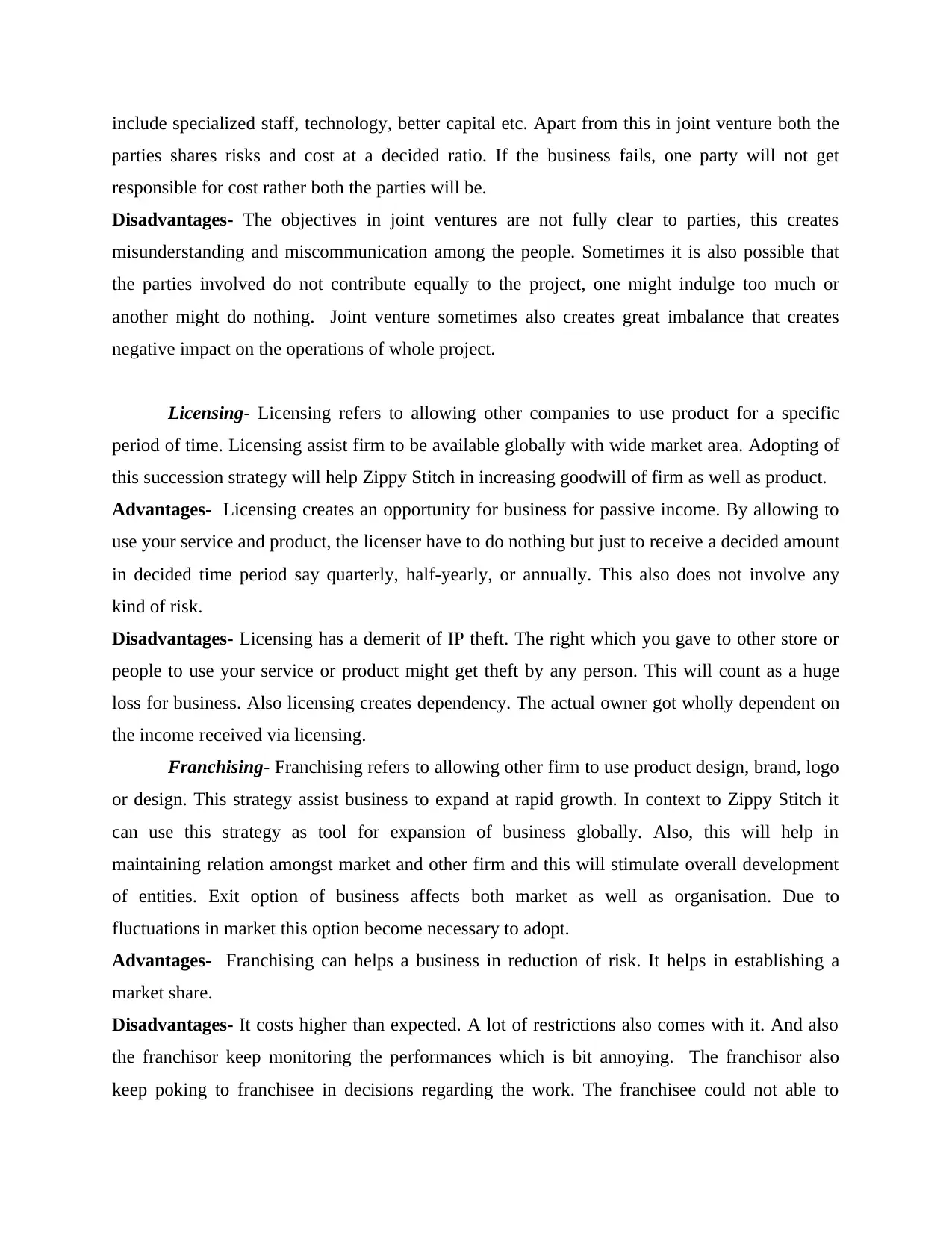
include specialized staff, technology, better capital etc. Apart from this in joint venture both the
parties shares risks and cost at a decided ratio. If the business fails, one party will not get
responsible for cost rather both the parties will be.
Disadvantages- The objectives in joint ventures are not fully clear to parties, this creates
misunderstanding and miscommunication among the people. Sometimes it is also possible that
the parties involved do not contribute equally to the project, one might indulge too much or
another might do nothing. Joint venture sometimes also creates great imbalance that creates
negative impact on the operations of whole project.
Licensing- Licensing refers to allowing other companies to use product for a specific
period of time. Licensing assist firm to be available globally with wide market area. Adopting of
this succession strategy will help Zippy Stitch in increasing goodwill of firm as well as product.
Advantages- Licensing creates an opportunity for business for passive income. By allowing to
use your service and product, the licenser have to do nothing but just to receive a decided amount
in decided time period say quarterly, half-yearly, or annually. This also does not involve any
kind of risk.
Disadvantages- Licensing has a demerit of IP theft. The right which you gave to other store or
people to use your service or product might get theft by any person. This will count as a huge
loss for business. Also licensing creates dependency. The actual owner got wholly dependent on
the income received via licensing.
Franchising- Franchising refers to allowing other firm to use product design, brand, logo
or design. This strategy assist business to expand at rapid growth. In context to Zippy Stitch it
can use this strategy as tool for expansion of business globally. Also, this will help in
maintaining relation amongst market and other firm and this will stimulate overall development
of entities. Exit option of business affects both market as well as organisation. Due to
fluctuations in market this option become necessary to adopt.
Advantages- Franchising can helps a business in reduction of risk. It helps in establishing a
market share.
Disadvantages- It costs higher than expected. A lot of restrictions also comes with it. And also
the franchisor keep monitoring the performances which is bit annoying. The franchisor also
keep poking to franchisee in decisions regarding the work. The franchisee could not able to
parties shares risks and cost at a decided ratio. If the business fails, one party will not get
responsible for cost rather both the parties will be.
Disadvantages- The objectives in joint ventures are not fully clear to parties, this creates
misunderstanding and miscommunication among the people. Sometimes it is also possible that
the parties involved do not contribute equally to the project, one might indulge too much or
another might do nothing. Joint venture sometimes also creates great imbalance that creates
negative impact on the operations of whole project.
Licensing- Licensing refers to allowing other companies to use product for a specific
period of time. Licensing assist firm to be available globally with wide market area. Adopting of
this succession strategy will help Zippy Stitch in increasing goodwill of firm as well as product.
Advantages- Licensing creates an opportunity for business for passive income. By allowing to
use your service and product, the licenser have to do nothing but just to receive a decided amount
in decided time period say quarterly, half-yearly, or annually. This also does not involve any
kind of risk.
Disadvantages- Licensing has a demerit of IP theft. The right which you gave to other store or
people to use your service or product might get theft by any person. This will count as a huge
loss for business. Also licensing creates dependency. The actual owner got wholly dependent on
the income received via licensing.
Franchising- Franchising refers to allowing other firm to use product design, brand, logo
or design. This strategy assist business to expand at rapid growth. In context to Zippy Stitch it
can use this strategy as tool for expansion of business globally. Also, this will help in
maintaining relation amongst market and other firm and this will stimulate overall development
of entities. Exit option of business affects both market as well as organisation. Due to
fluctuations in market this option become necessary to adopt.
Advantages- Franchising can helps a business in reduction of risk. It helps in establishing a
market share.
Disadvantages- It costs higher than expected. A lot of restrictions also comes with it. And also
the franchisor keep monitoring the performances which is bit annoying. The franchisor also
keep poking to franchisee in decisions regarding the work. The franchisee could not able to
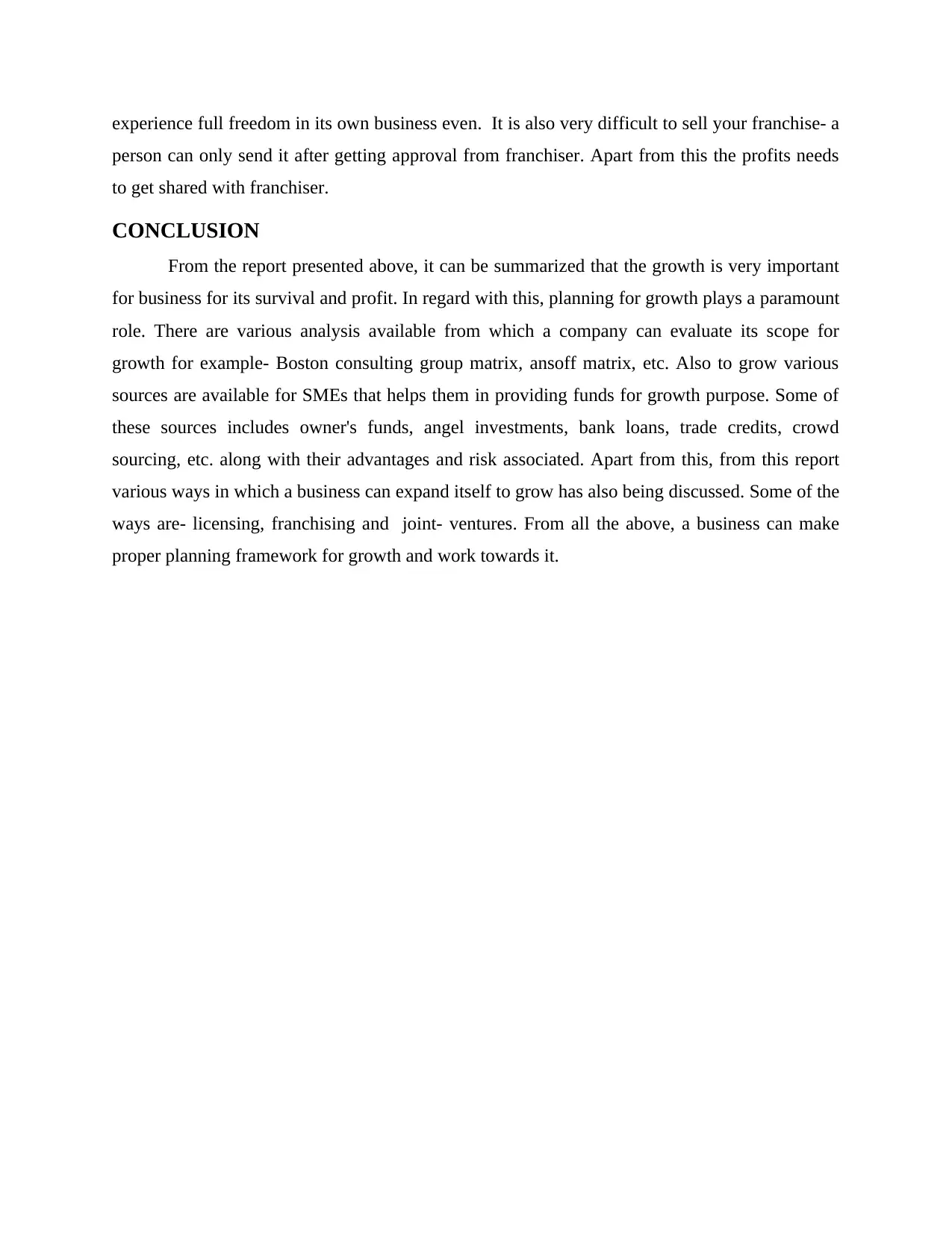
experience full freedom in its own business even. It is also very difficult to sell your franchise- a
person can only send it after getting approval from franchiser. Apart from this the profits needs
to get shared with franchiser.
CONCLUSION
From the report presented above, it can be summarized that the growth is very important
for business for its survival and profit. In regard with this, planning for growth plays a paramount
role. There are various analysis available from which a company can evaluate its scope for
growth for example- Boston consulting group matrix, ansoff matrix, etc. Also to grow various
sources are available for SMEs that helps them in providing funds for growth purpose. Some of
these sources includes owner's funds, angel investments, bank loans, trade credits, crowd
sourcing, etc. along with their advantages and risk associated. Apart from this, from this report
various ways in which a business can expand itself to grow has also being discussed. Some of the
ways are- licensing, franchising and joint- ventures. From all the above, a business can make
proper planning framework for growth and work towards it.
person can only send it after getting approval from franchiser. Apart from this the profits needs
to get shared with franchiser.
CONCLUSION
From the report presented above, it can be summarized that the growth is very important
for business for its survival and profit. In regard with this, planning for growth plays a paramount
role. There are various analysis available from which a company can evaluate its scope for
growth for example- Boston consulting group matrix, ansoff matrix, etc. Also to grow various
sources are available for SMEs that helps them in providing funds for growth purpose. Some of
these sources includes owner's funds, angel investments, bank loans, trade credits, crowd
sourcing, etc. along with their advantages and risk associated. Apart from this, from this report
various ways in which a business can expand itself to grow has also being discussed. Some of the
ways are- licensing, franchising and joint- ventures. From all the above, a business can make
proper planning framework for growth and work towards it.
Paraphrase This Document
Need a fresh take? Get an instant paraphrase of this document with our AI Paraphraser
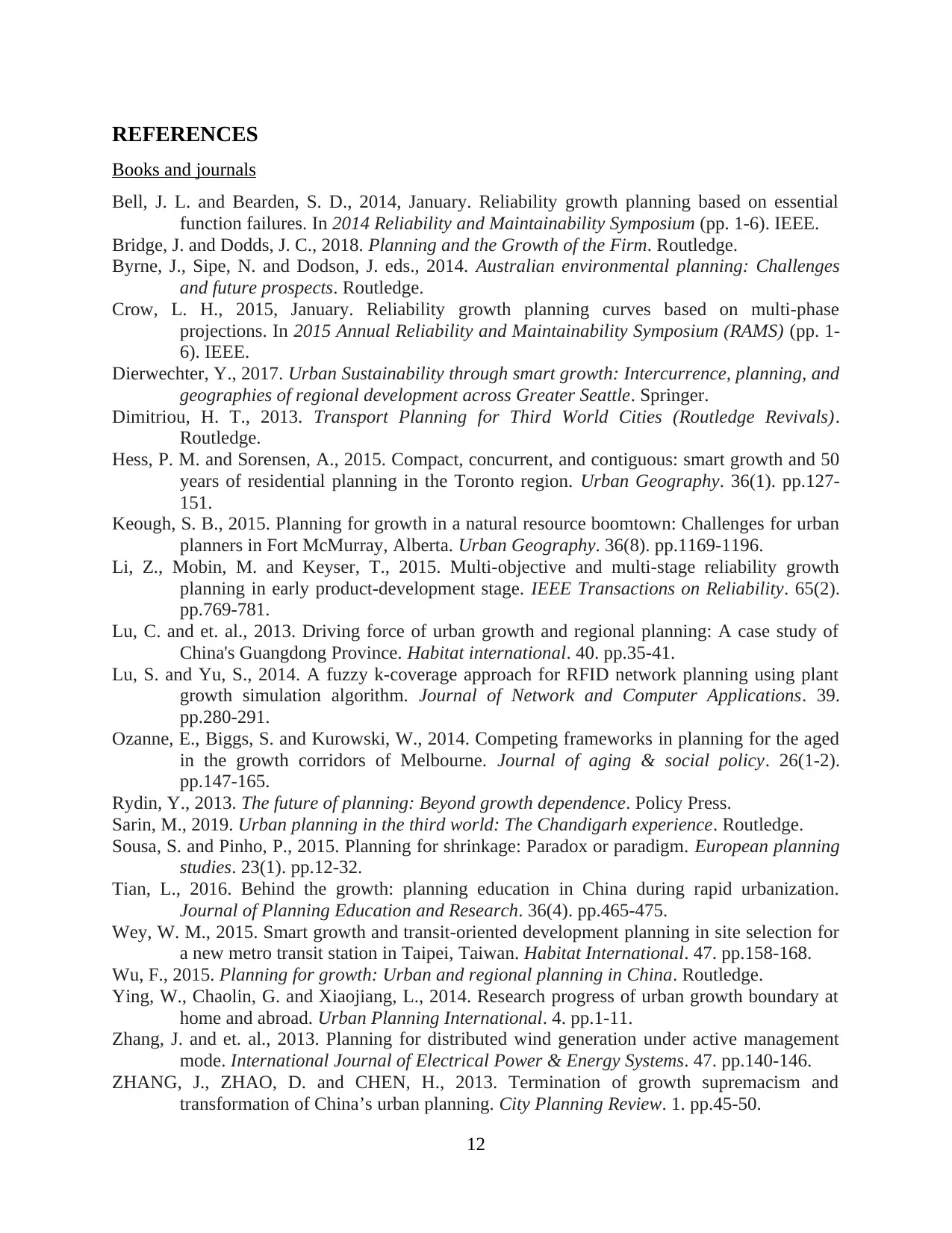
REFERENCES
Books and journals
Bell, J. L. and Bearden, S. D., 2014, January. Reliability growth planning based on essential
function failures. In 2014 Reliability and Maintainability Symposium (pp. 1-6). IEEE.
Bridge, J. and Dodds, J. C., 2018. Planning and the Growth of the Firm. Routledge.
Byrne, J., Sipe, N. and Dodson, J. eds., 2014. Australian environmental planning: Challenges
and future prospects. Routledge.
Crow, L. H., 2015, January. Reliability growth planning curves based on multi-phase
projections. In 2015 Annual Reliability and Maintainability Symposium (RAMS) (pp. 1-
6). IEEE.
Dierwechter, Y., 2017. Urban Sustainability through smart growth: Intercurrence, planning, and
geographies of regional development across Greater Seattle. Springer.
Dimitriou, H. T., 2013. Transport Planning for Third World Cities (Routledge Revivals).
Routledge.
Hess, P. M. and Sorensen, A., 2015. Compact, concurrent, and contiguous: smart growth and 50
years of residential planning in the Toronto region. Urban Geography. 36(1). pp.127-
151.
Keough, S. B., 2015. Planning for growth in a natural resource boomtown: Challenges for urban
planners in Fort McMurray, Alberta. Urban Geography. 36(8). pp.1169-1196.
Li, Z., Mobin, M. and Keyser, T., 2015. Multi-objective and multi-stage reliability growth
planning in early product-development stage. IEEE Transactions on Reliability. 65(2).
pp.769-781.
Lu, C. and et. al., 2013. Driving force of urban growth and regional planning: A case study of
China's Guangdong Province. Habitat international. 40. pp.35-41.
Lu, S. and Yu, S., 2014. A fuzzy k-coverage approach for RFID network planning using plant
growth simulation algorithm. Journal of Network and Computer Applications. 39.
pp.280-291.
Ozanne, E., Biggs, S. and Kurowski, W., 2014. Competing frameworks in planning for the aged
in the growth corridors of Melbourne. Journal of aging & social policy. 26(1-2).
pp.147-165.
Rydin, Y., 2013. The future of planning: Beyond growth dependence. Policy Press.
Sarin, M., 2019. Urban planning in the third world: The Chandigarh experience. Routledge.
Sousa, S. and Pinho, P., 2015. Planning for shrinkage: Paradox or paradigm. European planning
studies. 23(1). pp.12-32.
Tian, L., 2016. Behind the growth: planning education in China during rapid urbanization.
Journal of Planning Education and Research. 36(4). pp.465-475.
Wey, W. M., 2015. Smart growth and transit-oriented development planning in site selection for
a new metro transit station in Taipei, Taiwan. Habitat International. 47. pp.158-168.
Wu, F., 2015. Planning for growth: Urban and regional planning in China. Routledge.
Ying, W., Chaolin, G. and Xiaojiang, L., 2014. Research progress of urban growth boundary at
home and abroad. Urban Planning International. 4. pp.1-11.
Zhang, J. and et. al., 2013. Planning for distributed wind generation under active management
mode. International Journal of Electrical Power & Energy Systems. 47. pp.140-146.
ZHANG, J., ZHAO, D. and CHEN, H., 2013. Termination of growth supremacism and
transformation of China’s urban planning. City Planning Review. 1. pp.45-50.
12
Books and journals
Bell, J. L. and Bearden, S. D., 2014, January. Reliability growth planning based on essential
function failures. In 2014 Reliability and Maintainability Symposium (pp. 1-6). IEEE.
Bridge, J. and Dodds, J. C., 2018. Planning and the Growth of the Firm. Routledge.
Byrne, J., Sipe, N. and Dodson, J. eds., 2014. Australian environmental planning: Challenges
and future prospects. Routledge.
Crow, L. H., 2015, January. Reliability growth planning curves based on multi-phase
projections. In 2015 Annual Reliability and Maintainability Symposium (RAMS) (pp. 1-
6). IEEE.
Dierwechter, Y., 2017. Urban Sustainability through smart growth: Intercurrence, planning, and
geographies of regional development across Greater Seattle. Springer.
Dimitriou, H. T., 2013. Transport Planning for Third World Cities (Routledge Revivals).
Routledge.
Hess, P. M. and Sorensen, A., 2015. Compact, concurrent, and contiguous: smart growth and 50
years of residential planning in the Toronto region. Urban Geography. 36(1). pp.127-
151.
Keough, S. B., 2015. Planning for growth in a natural resource boomtown: Challenges for urban
planners in Fort McMurray, Alberta. Urban Geography. 36(8). pp.1169-1196.
Li, Z., Mobin, M. and Keyser, T., 2015. Multi-objective and multi-stage reliability growth
planning in early product-development stage. IEEE Transactions on Reliability. 65(2).
pp.769-781.
Lu, C. and et. al., 2013. Driving force of urban growth and regional planning: A case study of
China's Guangdong Province. Habitat international. 40. pp.35-41.
Lu, S. and Yu, S., 2014. A fuzzy k-coverage approach for RFID network planning using plant
growth simulation algorithm. Journal of Network and Computer Applications. 39.
pp.280-291.
Ozanne, E., Biggs, S. and Kurowski, W., 2014. Competing frameworks in planning for the aged
in the growth corridors of Melbourne. Journal of aging & social policy. 26(1-2).
pp.147-165.
Rydin, Y., 2013. The future of planning: Beyond growth dependence. Policy Press.
Sarin, M., 2019. Urban planning in the third world: The Chandigarh experience. Routledge.
Sousa, S. and Pinho, P., 2015. Planning for shrinkage: Paradox or paradigm. European planning
studies. 23(1). pp.12-32.
Tian, L., 2016. Behind the growth: planning education in China during rapid urbanization.
Journal of Planning Education and Research. 36(4). pp.465-475.
Wey, W. M., 2015. Smart growth and transit-oriented development planning in site selection for
a new metro transit station in Taipei, Taiwan. Habitat International. 47. pp.158-168.
Wu, F., 2015. Planning for growth: Urban and regional planning in China. Routledge.
Ying, W., Chaolin, G. and Xiaojiang, L., 2014. Research progress of urban growth boundary at
home and abroad. Urban Planning International. 4. pp.1-11.
Zhang, J. and et. al., 2013. Planning for distributed wind generation under active management
mode. International Journal of Electrical Power & Energy Systems. 47. pp.140-146.
ZHANG, J., ZHAO, D. and CHEN, H., 2013. Termination of growth supremacism and
transformation of China’s urban planning. City Planning Review. 1. pp.45-50.
12

Zhou, Y. and et. al., 2017. The effect of land use planning (2006–2020) on construction land
growth in China. Cities. 68. pp.37-47.
Online
Jurevicius, O., 2020. GE McKinsey Matrix. [Online]. Available through:
<https://strategicmanagementinsight.com/tools/ge-mckinsey-matrix.html>.
13
growth in China. Cities. 68. pp.37-47.
Online
Jurevicius, O., 2020. GE McKinsey Matrix. [Online]. Available through:
<https://strategicmanagementinsight.com/tools/ge-mckinsey-matrix.html>.
13
1 out of 15
Related Documents
Your All-in-One AI-Powered Toolkit for Academic Success.
+13062052269
info@desklib.com
Available 24*7 on WhatsApp / Email
![[object Object]](/_next/static/media/star-bottom.7253800d.svg)
Unlock your academic potential
© 2024 | Zucol Services PVT LTD | All rights reserved.




